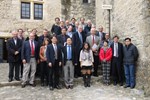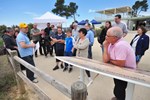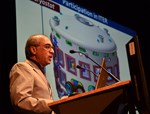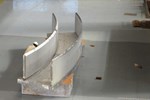ITER NEWSLINE

How does one review the preparations for the assembly and installation of several million pieces on a first-of-a-kind machine such as ITER? The first step is to bring together 14 experts from a variety of backgrounds—nuclear plant construction, fusion machine assembly, cryogenic plant, large-scale project management, building construction, system engineering and more.
This is what happened at the Château de Cadarache near ITER last week from 9 to 13 December.
The ITER Organization presented to a review panel its approach to planning and scheduling this enormous task, considering the design of the systems to be installed, the physical and practical constraints, the processes to be followed and the identified risks. Installation engineers from the Assembly & Operations Division are combining their knowledge with colleagues from the technical departments responsible for designing each system and are currently working with construction planners in order to estimate the time needed for each step of the assembly.
The Indian Domestic Agency also presented its plan for the work it will do on site to build the critical cryogenic piping and storage systems.
Adding in the crew of workers needed for each assembly or installation task, the result is a "resource loaded schedule" which is stored in Primavera (P6) software to calculate the overall time and resources needed. The totality of this information is the ITER Organization Integrated Assembly & Installation Plan—or, "How To Build a Tokamak."
The realism of this plan is critical to forecasting when the ITER machine will be turned over to operation and the beginning of its experimental phase.
The review panel digested a huge amount of information in a very short time during some very intensive sessions. They asked searching and challenging questions, analyzed the information given to them and by the end of the week had already given a positive initial report to ITER senior management and the Assembly & Operations Division.
A final report will be issued in January, at which time the ITER Organization will draw upon the panel's valuable comments and recommendations as it moves forward to complete the final plan in time for work to start in 2015.
http://www.iter.org/newsline/294/1806-Ken Blackler, head of the Assembly & Operations Division
The ITER correction coils are an integral part of the ITER magnet system, forming a layer of coils inserted in between the toroidal and poloidal field coils. Some of them, such as the six bottom correction coils, will be among the first components to be installed during assembly thus requiring early delivery to the ITER site.
On 4 and 5 December, the correction coil manufacturing line in China underwent a thorough check-up to assess whether it is now ready for the long marathon of correction coil manufacture. This critical examination was carried out by a group of "doctors" from Europe, Japan, USA and China under the chairmanship of Michel Huguet, former director of the ITER Naka site during the Engineering Design Activities for ITER. This first Manufacturing Readiness Review was organized by the ITER Organization and held at ASIPP (Hefei, China), the institute that was awarded the responsibility of correction coil manufacture by the Chinese Domestic Agency following the signature of the Procurement Arrangement in May 2010.
Four years ago, in November 2009, the Final Design Review was held in Hefei for this component. Since that time, a new manufacturing line for the correction coils was designed, manufactured or procured, and commissioned by ASIPP, including the winding line, the resin system for vacuum pressure impregnation (VPI), and the laser welding system for case enclosure. All the manufacturing drawings have been designed and approved, the qualification of various manufacturing processes has begun, and the winding qualification is finished.
The qualification items falling into the scope of the review included the winding of the 10 kA niobium-titanium (NbTi) conductor; the helium inlets and outlets which will provide supercritical cooling at 4.5 K; the terminal joints connecting the coil to the feeders; the glass-polyimide insulation and its impregnation by epoxy resin; the terminal service box hosting piping and insulating breaks; and the stainless steel case enclosing the winding-pack. The requirements and deliverables for each one were presented by Li Hongwei, the Technical Responsible Officer at ITER China, and the qualification work was presented by Wei Jing and her team at ASIPP.
The review panel commended both for the quality of their presentations, fully impressed by the achievements of the R&D and qualification activities. In particular, conductor winding has successfully passed all qualification examinations, opening the way for the winding of the first-of-series ITER correction coil with real superconductor in 2014.
A visit of the correction coil manufacturing workshop allowed the review panel the chance to see the various mockups built for the qualification of the manufacturing procedures, including the insulated side correction coil dummy double pancake and the bottom correction coil dummy double pancake (above right) ready for impregnation, as well the correction coil case models (above left).
http://www.iter.org/newsline/294/1802-Paul Libeyre, Central Solenoid and Correction Coil Section leader
On 4 and 5 December, the correction coil manufacturing line in China underwent a thorough check-up to assess whether it is now ready for the long marathon of correction coil manufacture. This critical examination was carried out by a group of "doctors" from Europe, Japan, USA and China under the chairmanship of Michel Huguet, former director of the ITER Naka site during the Engineering Design Activities for ITER. This first Manufacturing Readiness Review was organized by the ITER Organization and held at ASIPP (Hefei, China), the institute that was awarded the responsibility of correction coil manufacture by the Chinese Domestic Agency following the signature of the Procurement Arrangement in May 2010.
Four years ago, in November 2009, the Final Design Review was held in Hefei for this component. Since that time, a new manufacturing line for the correction coils was designed, manufactured or procured, and commissioned by ASIPP, including the winding line, the resin system for vacuum pressure impregnation (VPI), and the laser welding system for case enclosure. All the manufacturing drawings have been designed and approved, the qualification of various manufacturing processes has begun, and the winding qualification is finished.
The qualification items falling into the scope of the review included the winding of the 10 kA niobium-titanium (NbTi) conductor; the helium inlets and outlets which will provide supercritical cooling at 4.5 K; the terminal joints connecting the coil to the feeders; the glass-polyimide insulation and its impregnation by epoxy resin; the terminal service box hosting piping and insulating breaks; and the stainless steel case enclosing the winding-pack. The requirements and deliverables for each one were presented by Li Hongwei, the Technical Responsible Officer at ITER China, and the qualification work was presented by Wei Jing and her team at ASIPP.
The review panel commended both for the quality of their presentations, fully impressed by the achievements of the R&D and qualification activities. In particular, conductor winding has successfully passed all qualification examinations, opening the way for the winding of the first-of-series ITER correction coil with real superconductor in 2014.
A visit of the correction coil manufacturing workshop allowed the review panel the chance to see the various mockups built for the qualification of the manufacturing procedures, including the insulated side correction coil dummy double pancake and the bottom correction coil dummy double pancake (above right) ready for impregnation, as well the correction coil case models (above left).
http://www.iter.org/newsline/294/1802-Paul Libeyre, Central Solenoid and Correction Coil Section leader
Communication
Entering a new era
As the ITER Project evolves and becomes more "concrete," ITER Communication has to evolve too. Over the end-of-year holidays and into January, we'll be stopping the publication of Newsline. This longer-than-usual break will allow us to take the time to develop some new communication tools and refresh the ITER website. Our aim is to reach a wider audience with high quality information.
Many ITER visitors often call on us to devote more resources to public communication, reaching out not only to the fusion community but also to the public, to young people and to the business world. The argument given is nearly always the same: too many people do not know about ITER at all! Public awareness is a key factor for the success of the project as a whole. As public interest increases we have to develop the tools to answer their questions and concerns.
Last week we launched a new magazine in French (an English version will follow). Through a journalistic approach, it aims to popularize the science and technology behind and beyond ITER. Ahead, we'll be taking a fresh look at the public website to make it more attractive and up-to-date. And we'll be simplifying Newsline production to make it more reactive, punctual and comprehensive.
The ITER Project is entering a new era and so is its public communication. Best wishes for the New Year to all of you!
http://www.iter.org/newsline/294/1804-Michel Claessens, head of Communication & External Relations
Many ITER visitors often call on us to devote more resources to public communication, reaching out not only to the fusion community but also to the public, to young people and to the business world. The argument given is nearly always the same: too many people do not know about ITER at all! Public awareness is a key factor for the success of the project as a whole. As public interest increases we have to develop the tools to answer their questions and concerns.
Last week we launched a new magazine in French (an English version will follow). Through a journalistic approach, it aims to popularize the science and technology behind and beyond ITER. Ahead, we'll be taking a fresh look at the public website to make it more attractive and up-to-date. And we'll be simplifying Newsline production to make it more reactive, punctual and comprehensive.
The ITER Project is entering a new era and so is its public communication. Best wishes for the New Year to all of you!
http://www.iter.org/newsline/294/1804-Michel Claessens, head of Communication & External Relations
Over its 75 years of existence, the Indian conglomerate Larsen & Toubro Ltd. has built solar and nuclear plants, ports and airports, supertankers and submarines and even the Mangalyaan rocket that blasted off to Mars a little more than a month ago.
Now, the company's Heavy Engineering division has launched the fabrication process of an object that does not resemble anything it has previously produced: the ITER cryostat, the largest high-vacuum pressure chamber ever built, a component that is very large (30 x 30 metres), very heavy (3,800 tonnes) and of mind-boggling complexity.
Larsen & Toubro Ltd. of course does not lack experience in large, heavy components or machinery. And in terms of complexity a Mars-bound rocket can probably compete with a tokamak cryostat. Still, there are challenges in the fabrication of this unique component that the company has never faced.
"One of the major challenges is to manage the interaction between the designers and the manufacturer," explained M.V. Kotwal, the president of the company's Heavy Engineering division as he sat for an interview with Newsline at MIIFED 2013 in Monaco. "Some parts of the cryostat are frozen, others are not and this is something we are not accustomed to. In a situation like this, we need a constant and very smooth communication."
The ITER cryostat is "a huge assembly" and the industry needs to know precisely, and much ahead of time, what the final object will be like. "This is a concern more than a challenge, but we need to understand what the interfaces will be and for this, we also need a strong communication with the other manufacturers. In this kind of project, you definitely need to bring people together..."
Manufacturing the ITER cryostat, even for a company as experienced as Larsen & Toubro Ltd., requires the development of new technologies. "Our engineers and technicians master about 6,000 welding techniques for different materials. But the ITER cryostat is so 'special' that we'll need to develop a couple more..."
The ITER cryostat being one of the major Safety Important Components (SIC) in the ITER installation, drastic regulations apply. "We have experience with the US safety codes, but we haven't been exposed, yet, to the French safety requirements that ITER observes. In this context, we will have, for instance, to develop metrology and specific ultrasonic inspection techniques. We have to adapt to ITER standards."
Larsen & Toubro Ltd. also has to design specific machinery, fitting both the demands of the component and the space available in the workshop. "The machine has to be brought to the component, and not the other way around as is customary...but this is something we have experience in: we did it for India's fast breeder nuclear reactor."
In Hazira, on the north-western coast of the country where Larsen & Toubro operates one of its large engineering workshops, the first load of raw material has arrived. This will allow the fabrication of the first of a series of mockups that will be used to qualify the welding process.
"A well-made product is no good if it is not delivered well," claims the Larsen & Toubro Ltd. promotional video that M.V. Kotwal presented at MIIFED. During the long journey from Hazira to Saint-Paul-lez-Durance, the 54 "modules" that make up the four major assemblies of the ITER cryostat (top lid, upper cylinder, lower cylinder and base section) will travel inside specially designed "packing cages".
Delivery of the first modules on the ITER site is expected in less than two years.
http://www.iter.org/newsline/294/1792-Robert Arnoux
For the past 13 years, a group of some 350 physicists throughout the world has been working to integrate knowledge and data for the ITER Project.
The International Tokamak Physics Activity (ITPA) was established in 2001 under the auspices of the International Atomic Energy Agency. In 2008, the seven ITPA "Topical Groups" and their Coordinating Committee passed under the umbrella of ITER.
Last week at ITER, the ITPA Coordinating Committee met for the 16th time to review and discuss the experiments performed in 2013 in support of ITER and to examine the proposals for the following year.
Newsline seized the opportunity to sit with Yutaka Kamada who has chaired the ITPA Coordinating Committee since December 2010. (Dr Abhijit Sen of the Institute for Plasma Research, India will take over as Chair of the Coordinating Committee on 1 January 2014.)
How does the ITPA work?
ITPA is principally a group of physicists, and some engineers also, working in different fusion labs around the world and contributing to the establishment of a broad physics basis for ITER and what lies beyond — the DEMO project and future industrial fusion power plants.
How does this translate concretely?
Presently, ITPA coordinates 56 "joint experiments" in different tokamaks throughout the world. Suppose something interesting happens in ASDEX (Germany) for instance. We'll propose to reproduce it on, for instance, KSTAR (Korea) ... and then we extrapolate to ITER. This is the main idea: scaling towards ITER through extrapolation.
Experiments are not all, however. Theory and simulation play a large role in building knowledge and data into ITER.
How do you choose your research priorities?
There are topics with some urgency attached to them and others that are more long-term concerns. The divertor material issue certainly fell into the first category and for two years we concentrated on it, asking the different topical groups to assess the advantages and disadvantages of tungsten. Eventually we recommended the use a tungsten divertor. And in October the ITER STAC agreed with this recommendation, leading the ITER Council, on 20-21 November, to endorse the Director General's proposal to commence ITER operations with a tungsten divertor, rather than a carbon-fibre divertor that would have been replaced during the second phase of operations
Before this, it was ELM control that kept us busy...
What are the present priorities, now that the divertor issue is closed?
In the "urgency" category, it is certainly disruptions. In the longer-term, it is steady-state operation. And of course, continuous physics research, which is our core activity.
http://www.iter.org/newsline/294/1805-R.A.








